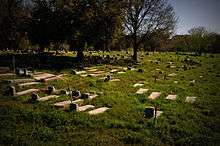Africatown
|
Africatown Historic District | |
|
Abandoned house in Africatown | |
 | |
| Location | Roughly bounded by Jakes Ln., Paper Mill, & Warren Rds., Chin, & Railroad Sts., Mobile, Alabama |
|---|---|
| Coordinates | 30°44′7″N 88°3′31″W / 30.73528°N 88.05861°WCoordinates: 30°44′7″N 88°3′31″W / 30.73528°N 88.05861°W |
| NRHP Reference # | 12000990[1] |
| Added to NRHP | December 4, 2012[1] |
Africatown, also known as AfricaTown USA and Plateau, is a community located three miles (5 km) north of downtown Mobile, Alabama. It was formed by West Africans who were among the last known illegal shipment of slaves to the United States. These people created their own community and retained their customs and language following the American Civil War.[2]
History
Africatown had its beginnings in an 1860 plan by some wealthy slavemasters and their friends to see if they could evade the law and import slaves from Africa. They bet each other they could elude federal authorities. Timothy Meaher, a shipbuilder and landowner; his brother Byrnes Meaher, John Dabey and others invested money to hire a crew and captain for one of Meaher's ships to go to Africa and bring back laborers for slaves.
They used Timothy Meaher's ship Clotilde under Captain William Foster. It sailed in 1860 from Ghana, West Africa for its final destination of Mobile, more than half a century after the slave trade had been outlawed by the United States in 1808. Over 100 Africans were aboard, having been sold into bondage by the King of Dahomey. Dahomey warriors raided a village near the city of Tamale in Ghana, and took the survivors to Whydah, now Benin, where they were put up for sale. The captured tribesmen were sold for $100 each to William Foster, captain of the Clotilde.[2][3][4]

In July 1860, the Clotilde entered Mobile Bay and approached the port of Mobile. Captain Foster loaded the slaves onto a riverboat and sent them ashore; he set fire to the Clotilde to hide the evidence of its captives. The Africans were distributed among the parties who had invested in the venture. Federal authorities learned of this illegal activity and prosecuted Meaher and his partners. The 1861 federal court case of US v. Byrnes Meaher, Timothy Meaher and John Dabey did not find enough evidence to convict Meaher. The case was dismissed. The start of the American Civil War was believed to have been important in the government's dropping the case.[2][3][4]
Thirty-two Africans had been taken to Magazine Point, the property owned by Timothy Meaher north of Mobile. As the government was investigating the illegal importation, the Africans were left on their own to survive. This was the site that was developed by them as what became known as Africatown. Among the Africans was a man named Cudjoe Kazoola Lewis, who was the last survivor of the original group, living until 1935.[2][3][4]
The group built shelters of whatever they found growing in the Alabama forests, and adapted their hunting to the rich game they found in the area. After the Civil War and emancipation, they were joined by a number of their fellow tribesmen. A man who became known as Charlie Poteet was their chief; their medicine man was named Jabez. In time, they formed a self-governing society. They spoke their native language and carried on their tribal traditions into the 1950s.[4]
Gradually the original group of settlers and their descendants dwindled, as people moved to other areas. Their children went to public schools and learned English. Remaining members would gather on Sundays after church to discuss the group's welfare. Of the remaining people, Cudjoe Lewis was the best known. He gave interviews to the many writers who studied Africatown during the early 20th century. Up until World War II, Africatown survived as a distinct community.[4]
Historic district

Most of the community now lies within Mobile's northern city limits. In 1997, descendants and friends formed the Africatown Community Mobilization Project to seek recognition of an Africatown Historical District and encourage the restoration and development of the town site.[2][3]
The site was placed on Mobile's African American Heritage Trail in 2009.[5] The Africatown Historic District was subsequently designated by the National Park Service and listed on the National Register of Historic Places on December 4, 2012. The historic district is encompassed by Jakes Lane, Paper Mill Road, Warren Road (Bay Bridge Road), Chin Street, and Railroad Street.[1]
See also
References
- 1 2 3 "Weekly List of Actions Taken On Properties: 12/03/12 Through 12/07/12". National Register of Historic Places. National Park Service. Retrieved January 6, 2013.
- 1 2 3 4 5 Willet, Henry. "Mobile Community Holds On To Unique African Heritage". "Alabama Center for Traditional Culture". Retrieved 2008-02-28.
- 1 2 3 4 "AfricaTown, USA". "The Library of Congress: Local Legacies". Retrieved 2008-02-28.
- 1 2 3 4 5 "Africatown, Alabama". "Wilson Jay's South". Archived from the original on 7 March 2008. Retrieved 2008-02-28.
- ↑ "African American Heritage Trails". Mobile Historic Development Commission. City of Mobile. Archived from the original on 3 June 2010. Retrieved 20 April 2010.
Further reading
- Diouf, Sylviane Anna. Dreams of Africa in Alabama: The Slave Ship Clotilda and the Story of the Last Africans Brought to America. New York: Oxford University Press, 2007.
- Hurston, Zora Neale. Barracoon. Unpublished typescripts and hand-written draft, 1931. Alan Locke Collection, Manuscript Department, Moorland-Spingarn Research Center, Howard University.
- Roche, Emma Langdon. Historic Sketches of the South. New York: Knickerbocker Press, 1914.
External links
- "Africatown", Encyclopedia of Alabama
